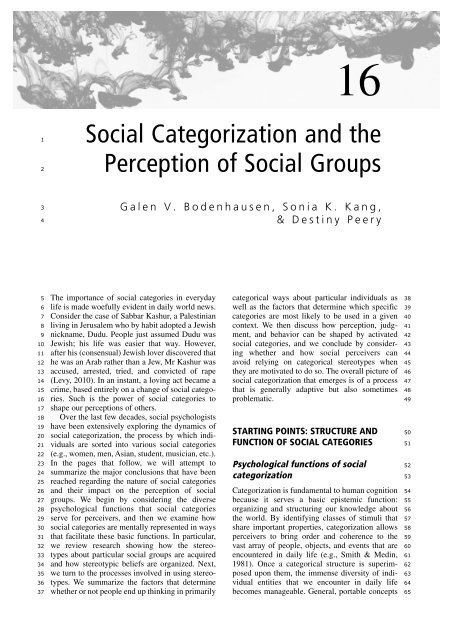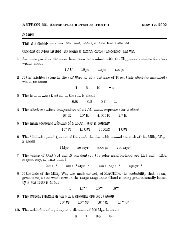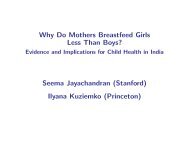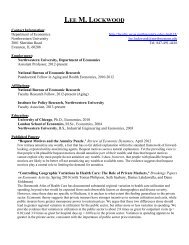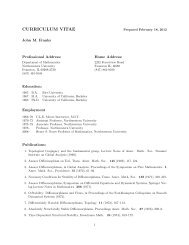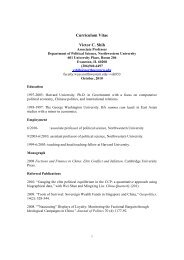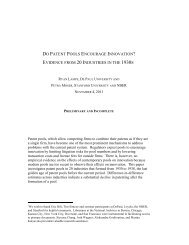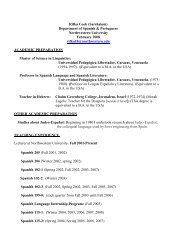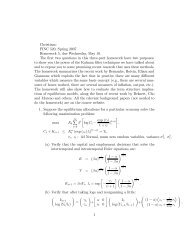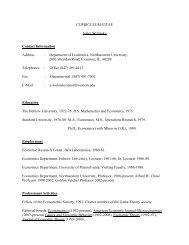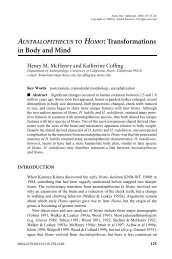Social Categorization and the Perception of Social Groups
Social Categorization and the Perception of Social Groups
Social Categorization and the Perception of Social Groups
You also want an ePaper? Increase the reach of your titles
YUMPU automatically turns print PDFs into web optimized ePapers that Google loves.
1612<strong>Social</strong> <strong>Categorization</strong> <strong>and</strong> <strong>the</strong><strong>Perception</strong> <strong>of</strong> <strong>Social</strong> <strong>Groups</strong>34Galen V. Bodenhausen, Sonia K. Kang,& Destiny Peery5678910111213141516171819202122232425262728293031323334353637The importance <strong>of</strong> social categories in everydaylife is made woefully evident in daily world news.Consider <strong>the</strong> case <strong>of</strong> Sabbar Kashur, a Palestinianliving in Jerusalem who by habit adopted a Jewishnickname, Dudu. People just assumed Dudu wasJewish; his life was easier that way. However,after his (consensual) Jewish lover discovered tha<strong>the</strong> was an Arab ra<strong>the</strong>r than a Jew, Mr Kashur wasaccused, arrested, tried, <strong>and</strong> convicted <strong>of</strong> rape(Levy, 2010). In an instant, a loving act became acrime, based entirely on a change <strong>of</strong> social categories.Such is <strong>the</strong> power <strong>of</strong> social categories toshape our perceptions <strong>of</strong> o<strong>the</strong>rs.Over <strong>the</strong> last few decades, social psychologistshave been extensively exploring <strong>the</strong> dynamics <strong>of</strong>social categorization, <strong>the</strong> process by which individualsare sorted into various social categories(e.g., women, men, Asian, student, musician, etc.).In <strong>the</strong> pages that follow, we will attempt tosummarize <strong>the</strong> major conclusions that have beenreached regarding <strong>the</strong> nature <strong>of</strong> social categories<strong>and</strong> <strong>the</strong>ir impact on <strong>the</strong> perception <strong>of</strong> socialgroups. We begin by considering <strong>the</strong> diversepsychological functions that social categoriesserve for perceivers, <strong>and</strong> <strong>the</strong>n we examine howsocial categories are mentally represented in waysthat facilitate <strong>the</strong>se basic functions. In particular,we review research showing how <strong>the</strong> stereotypesabout particular social groups are acquired<strong>and</strong> how stereotypic beliefs are organized. Next,we turn to <strong>the</strong> processes involved in using stereotypes.We summarize <strong>the</strong> factors that determinewhe<strong>the</strong>r or not people end up thinking in primarilycategorical ways about particular individuals aswell as <strong>the</strong> factors that determine which specificcategories are most likely to be used in a givencontext. We <strong>the</strong>n discuss how perception, judgment,<strong>and</strong> behavior can be shaped by activatedsocial categories, <strong>and</strong> we conclude by consideringwhe<strong>the</strong>r <strong>and</strong> how social perceivers canavoid relying on categorical stereotypes when<strong>the</strong>y are motivated to do so. The overall picture <strong>of</strong>social categorization that emerges is <strong>of</strong> a processthat is generally adaptive but also sometimesproblematic.STARTING POINTS: STRUCTURE ANDFUNCTION OF SOCIAL CATEGORIESPsychological functions <strong>of</strong> socialcategorization<strong>Categorization</strong> is fundamental to human cognitionbecause it serves a basic epistemic function:organizing <strong>and</strong> structuring our knowledge about<strong>the</strong> world. By identifying classes <strong>of</strong> stimuli thatshare important properties, categorization allowsperceivers to bring order <strong>and</strong> coherence to <strong>the</strong>vast array <strong>of</strong> people, objects, <strong>and</strong> events that areencountered in daily life (e.g., Smith & Medin,1981). Once a categorical structure is superimposedupon <strong>the</strong>m, <strong>the</strong> immense diversity <strong>of</strong> individualentities that we encounter in daily lifebecomes manageable. General, portable concepts383940414243444546474849505152535455565758596061626364655698_Fiske-Ch16.indd 31811/16/2011 2:38:11 PM
322THE SAGE HANDBOOK OF SOCIAL COGNITION1 are likely to be tuned to <strong>the</strong> immediate context2 (Smith & Conrey, 2007), particularly <strong>the</strong> salient3 comparative context (e.g., Brown & Turner, 2002).4 Theoretical notions <strong>of</strong> category representation5 have become increasingly dynamic in recent6 thinking. As Smith <strong>and</strong> Conrey argue, it may be7 preferable to think <strong>of</strong> mental representations as8 being more like transitory states than enduring9 entities − although <strong>the</strong>re is most assuredly a nontrivialdegree <strong>of</strong> continuity in <strong>the</strong>se representa-1011 tional states.12 The contextualization <strong>of</strong> category representationshas been documented in a number <strong>of</strong> studies1314 showing that <strong>the</strong> automatic associations that are15 triggered by category members can change across16 different circumstances. For example, Wittenbrink,17 Judd, <strong>and</strong> Park (2001) showed that automatic18 evaluative associations triggered by African19 American targets varied as a function <strong>of</strong> <strong>the</strong> settingin which a target was encountered. The very2021 same individuals elicited more positive evaluationswhen seen in church as compared to on an2223 urban street corner. Along similar lines, Barden,24 Maddux, Petty, <strong>and</strong> Brewer (2004) showed that25 <strong>the</strong> social role occupied by an African American26 target moderated <strong>the</strong> degree <strong>of</strong> automatic prejudicethat was elicited by exposure to <strong>the</strong> target;2728 for example, a Black person elicited more favorableautomatic evaluations when depicted as a2930 lawyer than when depicted as a prisoner. As a final31 example, Correll, Park, Judd, <strong>and</strong> Wittenbrink32 (2007) showed that reading a newspaper story33 about a Black criminal made participants more34 likely to commit racially biased errors in a simulatedpolice decision-making task requiring <strong>the</strong>m3536 to “shoot” individuals holding weapons (includingbeing more likely to shoot a Black target hold-3738 ing an innocuous object such as a cell phone).39 These kinds <strong>of</strong> effects are typically understood to40 reflect <strong>the</strong> fact that some social categories, like41 “African Americans,” are actually quite multifaceted<strong>and</strong> are likely to be represented in an evalu-4243 atively heterogeneous way; only a subset <strong>of</strong> <strong>the</strong>44 potential associations will be activated in any45 given circumstance, <strong>and</strong> <strong>the</strong> particular subset that46 does become activated is influenced by <strong>the</strong> salient47 context (see Gawronski & Bodenhausen, 2006, in48 press).49 A great deal remains to be learned about what50 is general <strong>and</strong> what is context-specific in representations<strong>of</strong> social groups. Gawronski, Rydell,5152 Vervliet, <strong>and</strong> De Houwer (2010) have provided53 some very promising new insights about this issue54 in <strong>the</strong> domain <strong>of</strong> implicit attitudes. They focus on55 <strong>the</strong> role <strong>of</strong> attention to context cues in determining56 <strong>the</strong> generality <strong>of</strong> automatic evaluation. When individualsform a new evaluative representation <strong>of</strong> a5758 given category, <strong>the</strong> surrounding context may or59 may not be salient. For example, if you meet somefriendly Bosnians at a party, you may form apositive impression <strong>of</strong> Bosnians without particularlynoting <strong>the</strong> context in which <strong>the</strong> positivity wasexperienced. This experience will thus lead to arelatively decontextualized positive automaticevaluation <strong>of</strong> <strong>the</strong> group. However, if you subsequentlyhave a bad experience with a Bosnian,you are quite likely to be attentive to <strong>the</strong> context(because <strong>the</strong> unexpectedness <strong>of</strong> <strong>the</strong> event triggersgreater analysis). By <strong>the</strong> logic <strong>of</strong> Gawronskiet al.’s reasoning, this pattern <strong>of</strong> experienceswould tend to produce automatic negative evaluations<strong>of</strong> Bosnians whenever <strong>the</strong>y are encounteredwithin <strong>the</strong> same context as <strong>the</strong> negative experience(“occasion setting” in <strong>the</strong>ir terminology), butautomatic evaluations should be positive in allo<strong>the</strong>r situations, activating <strong>the</strong> decontextualizedautomatic evaluation that was initially formed(a “renewal effect”). The time is certainly ripe formore research on stable (default) vs contextdrivenperceptions <strong>of</strong> social groups.Lay demographyThus far, we have written about social categoriesin a very general manner, focusing on generalfunctional <strong>and</strong> representational processes. We turnnow to some particulars, in an attempt to address<strong>the</strong> following questions:1. Which respects for social differentiation arechronically salient to social perceivers?2. What specific stereotypic content is associatedwith <strong>the</strong>se salient groups?3. How is this content acquired?As much as any object can be, people are infinitelycategorizable. Imagine encountering anunknown individual at a cocktail party. As yourinteraction progresses, this same person might becategorized as a woman, a teacher, a brunette, aLiberal, an oenophile, <strong>and</strong> a person with detachedearlobes. Of course, some <strong>of</strong> <strong>the</strong>se categories aremore useful <strong>and</strong> have more salient cues associatedwith <strong>the</strong>m than o<strong>the</strong>rs. As previously noted,research on category representation has establishedthat some categories are more “basic” thano<strong>the</strong>rs. In <strong>the</strong> case <strong>of</strong> people, researchers havenoted that basic demographic distinctions − age,race, gender, <strong>and</strong> social class − seem to serve as<strong>the</strong> most chronically salient categories (Brewer,1988; Fiske & Neuberg, 1990). The relative preeminence<strong>of</strong> <strong>the</strong>se categories no doubt relates to<strong>the</strong> fact <strong>the</strong>y are typically easily <strong>and</strong> immediatelyperceived.Evidence that individuals spontaneously usesex <strong>and</strong> race to categorize o<strong>the</strong>rs was provided byStangor, Lynch, Duan, <strong>and</strong> Glass (1992), who606162636465666768697071727374757677787980818283848586878889909192939495969798991001011021031041051061071081091101111121135698_Fiske-Ch16.indd 32211/16/2011 2:38:11 PM
SOCIAL CATEGORIZATION AND THE PERCEPTION OF SOCIAL GROUPS 3231 showed that memory for statements that had been2 made by a variety <strong>of</strong> individuals who differed on3 race <strong>and</strong> gender tended to be organized around <strong>the</strong>4 race <strong>and</strong> gender categories. Specifically, when5 memory errors occurred, it was more likely that6 a statement would be misattributed to a person7 having <strong>the</strong> same race or gender as <strong>the</strong> actual8 source, compared to cross-race or cross-sex9 memory errors. This tendency to group informationby sex <strong>and</strong> race was generally evident, but1011 it was more pronounced among individuals who12 were higher in prejudice. Using neuroscience13 methods, Ito <strong>and</strong> Url<strong>and</strong> (2003) showed that perceiversare attentive to <strong>the</strong> race <strong>and</strong> sex <strong>of</strong> a face1415 within a fraction <strong>of</strong> a second <strong>of</strong> its presentation16 (within 100 ms for race <strong>and</strong> 150 ms for gender).17 Studies <strong>of</strong> this sort clearly show that certain basic18 demographic categories are immediately encoded19 in an automatic manner, although <strong>the</strong> focus <strong>of</strong>20 categorization can subsequently shift across longer21 time periods (e.g., Kunda & Spencer, 2003).2223242526272829303132333435363738394041424344454647484950515253545556Stereotype contentThe process <strong>of</strong> categorization initiates <strong>the</strong> activation<strong>of</strong> a variety <strong>of</strong> stereotypes associated with <strong>the</strong>category in question. Though <strong>the</strong> content <strong>of</strong> <strong>the</strong>sestereotypes can be extremely varied (e.g., elderlypeople are slow; women are bad at math; homelesspeople are dangerous), over a decade <strong>of</strong> workon <strong>the</strong> stereotype content model (SCM; Fiske,Cuddy, Glick, & Xu, 2002) has shown that <strong>the</strong>content <strong>of</strong> stereotypes can be understood in terms<strong>of</strong> two fundamental dimensions: warmth <strong>and</strong> competence.The dimension <strong>of</strong> warmth (which encompassestraits like tolerant, warm, good-natured,<strong>and</strong> sincere) is concerned with a group’s goals inrelation to <strong>the</strong> self or in-group. As perceivers, wewant to know whe<strong>the</strong>r an individual or out-groupis a friend or foe − whe<strong>the</strong>r <strong>the</strong> “o<strong>the</strong>r” intendsto cooperate or compete (Fiske et al., 2002). Inaddition to knowledge about a target’s intentionto compete or cooperate, perceivers are alsoconcerned with <strong>the</strong> target’s ability to pursue thatintent. This capability to pursue one’s relativelypositive or negative intentions is described by <strong>the</strong>second dimension: competence. Competence(which encompasses traits like competent, confident,independent, <strong>and</strong> intelligent) describes <strong>the</strong>degree to which a target individual or group willbe effective at bringing about desired outcomes.In essence, <strong>the</strong> SCM asserts that perceivers differentiateindividuals <strong>and</strong> groups according to<strong>the</strong>ir predicted impact on <strong>the</strong> self or in-groupusing judgments <strong>of</strong> <strong>the</strong>ir perceived intent (warmth)<strong>and</strong> <strong>the</strong>ir ability (competence) to pursue thatintent (Cuddy, Fiske, & Glick, 2008). These samedimensions appear to organize social impressionin general (e.g., Judd, James-Hawkins, Yzerbyt, &Kashima, 2005; Wiggins, 1991).The SCM contends that social groups are <strong>of</strong>tencharacterized by ambivalent stereotypes, specificallyreflected in positive evaluation on onedimension but negative evaluation on <strong>the</strong> o<strong>the</strong>r.For example, in relation to one’s in-group, a groupcould be characterized as warm but not competent(e.g., <strong>the</strong> elderly). Alternatively, a group could becharacterized as competent but not warm (e.g.,Asians). Unfortunately, positive evaluation alongone dimension is not enough to overcome anoverall negative evaluation. Members <strong>of</strong> ambivalentlystereotyped groups are usually devalued <strong>and</strong>experience prejudice <strong>and</strong> discrimination relativeto groups that are perceived as both warm <strong>and</strong>competent (e.g., Cuddy, Norton, & Fiske, 2005;Glick, 2005).The SCM also outlines <strong>the</strong> emotional responsesthat are likely to be elicited by groups positionedat different points along <strong>the</strong> warmth <strong>and</strong> competencecontinua. <strong>Groups</strong> judged as high in bothwarmth <strong>and</strong> competence − usually only one’sin-group <strong>and</strong> “societal prototype groups” likeWhites, heterosexuals, <strong>and</strong> middle-class individuals(Cuddy et al., 2008) − elicit admiration. Incontrast, groups judged as nei<strong>the</strong>r warm nor competent(e.g., poor people, welfare recipients) elicitfeelings <strong>of</strong> contempt. These feelings <strong>of</strong> contemptare <strong>of</strong>ten associated with a host <strong>of</strong> related negativeemotions like disgust, anger, <strong>and</strong> resentment. Thetwo mixed quadrants also elicit relatively negativeemotions. <strong>Groups</strong> stereotyped as warm but notcompetent (e.g., elderly people, disabled people)elicit feelings <strong>of</strong> pity, while groups stereotypedas competent but not warm (e.g., Asians, Jews,rich people) elicit feelings <strong>of</strong> envy.A recent extension <strong>of</strong> <strong>the</strong> SCM, <strong>the</strong> “behaviorsfrom intergroup affect <strong>and</strong> stereotypes (BIAS)map” framework (Cuddy, Fiske, & Glick, 2007),links <strong>the</strong> contents <strong>of</strong> stereotypes <strong>and</strong> associatedemotions as identified by <strong>the</strong> SCM to actual discriminatorybehaviors. The BIAS map proposesfour distinct classes <strong>of</strong> out-group-related behaviorsthat fall along two dimensions: active vs passive<strong>and</strong> facilitative vs harmful. Active behaviorsare those involving directed effort toward <strong>the</strong>target group (e.g., a targeted attack on a synagogue),while passive behaviors are defined asthose having repercussions for an out-group butthat involve less directed effort (e.g., failing tohire Jewish job applicants). In addition to <strong>the</strong>effort with which <strong>the</strong>y are engaged, behaviorscan also be differentiated according to <strong>the</strong>irintended effect. This distinction is encompassedby <strong>the</strong> facilitative vs harmful dimension: facilitationrefers to behaviors intended to bring aboutfavorable outcomes or gains (e.g., donating moneyto an after-school program for inner-city youth),575859606162636465666768697071727374757677787980818283848586878889909192939495969798991001011021031041051061071081091101111121131141155698_Fiske-Ch16.indd 32311/16/2011 2:38:11 PM
SOCIAL CATEGORIZATION AND THE PERCEPTION OF SOCIAL GROUPS 3251 are segregated because <strong>the</strong>y differ in important2 ways. For example, children tend to think that3 some jobs are “for Black people” <strong>and</strong> o<strong>the</strong>r jobs4 are “for White people” even in <strong>the</strong> absence <strong>of</strong> any5 external adult instruction (Bigler, Averhart, &6 Liben, 2003). According to DIT, this knowledge7 would be gained simply by observing differences8 in perceptually salient features that characterize9 individuals in various pr<strong>of</strong>essions. In sum, DIT10 provides a useful framework for underst<strong>and</strong>ing11 how categories are first developed <strong>and</strong> conceptualizedby 12 children.13141516171819202122232425262728293031323334353637383940414243444546474849505152CATEGORIZATION IN ACTIONHaving addressed basic questions about <strong>the</strong> representationalstructure, psychological function, <strong>and</strong>specific content <strong>of</strong> social categories, we now turnour attention to <strong>the</strong> processes whereby <strong>the</strong>se categoriesinfluence our perceptions, judgments, <strong>and</strong>behaviors. Here, we address questions about when<strong>and</strong> how social categories become influential inperceptions <strong>of</strong> social groups <strong>and</strong> <strong>the</strong>ir individualmembers.<strong>Categorization</strong> versus individuationInfluential models <strong>of</strong> impression formation portrayour perceptions <strong>of</strong> o<strong>the</strong>rs as emerging withina tension between viewing o<strong>the</strong>rs categorically −as group members who are functionally interchangeablewith o<strong>the</strong>r individuals in <strong>the</strong> group − vsperceiving <strong>the</strong>m as individuals who are characterizedby a unique constellation <strong>of</strong> personal qualities(Brewer, 1988; Fiske & Neuberg, 1990). Oneapproach to analyzing <strong>the</strong> differences betweencategorization <strong>and</strong> individuation has been to focuson <strong>the</strong> type <strong>of</strong> content that is emphasized inimpression formation: category cues vs trait cues(see Bodenhausen, Macrae, & Sherman, 1999).On this view, individuation relies on more extensiveprocessing <strong>of</strong> trait (or behavior) cues, whereassuch cues are de-emphasized in categorization infavor <strong>of</strong> cues indicating membership in somenoteworthy social group. A key problem with thisapproach lies in <strong>the</strong> fact that <strong>the</strong> distinctionbetween traits <strong>and</strong> categories is ultimately hardto defend on <strong>the</strong> basis <strong>of</strong> content. A “trait” likeneurotic can easily define a category <strong>of</strong> (from<strong>the</strong> perceiver’s perspective) functionally interchangeablepeople − i.e., neurotic people − whilea “category” membership like Muslim can servemerely as one <strong>of</strong> many personal descriptors (<strong>and</strong>not as a basis for viewing <strong>the</strong> individual as interchangeablewith o<strong>the</strong>r category members). Thereare, to be sure, noteworthy differences betweendemographically defined social categories vstrait-based ones (see Bodenhausen et al., 1999),but <strong>the</strong> key difference between categorization<strong>and</strong> individuation does not appear to be reducibleto <strong>the</strong> type <strong>of</strong> content (e.g., traits vs demographiccues) emphasized in impression formation.A more promising approach is to build <strong>the</strong> distinctionbetween categorization <strong>and</strong> individuation onprocessing differences (e.g., Fiske & Neuberg,1990).When social impressions are categorical, aparticular group membership, trait, or o<strong>the</strong>r personalfeature provides <strong>the</strong> overarching organizing<strong>the</strong>me for perception <strong>and</strong> judgment, <strong>and</strong> a priori,generic knowledge is used schematically to producean impression in which <strong>the</strong> target is, for allintents <strong>and</strong> purposes, interchangeable with o<strong>the</strong>rmembers <strong>of</strong> <strong>the</strong> category defined by this feature.The particulars <strong>of</strong> <strong>the</strong> individual are not important;ra<strong>the</strong>r, <strong>the</strong> ways in which <strong>the</strong> individual typifiesthat general sort <strong>of</strong> person is <strong>of</strong> paramountconcern. Individuation, in contrast, refers to aprocess in which no particular aspect <strong>of</strong> a persondominates impression formation. Instead, multiplecharacteristics are considered <strong>and</strong> <strong>the</strong>ir implicationsare integrated in a more piecemeal process.Its end result is an impression focused on how <strong>the</strong>target person differs from o<strong>the</strong>r persons, ra<strong>the</strong>rthan on class equivalencies within a given group<strong>of</strong> persons.A great deal <strong>of</strong> research has examined <strong>the</strong>moderators <strong>of</strong> categorization vs individuation.<strong>Social</strong>, motivational, attentional, <strong>and</strong> dispositionalmoderating variables have been identified. Theimportance <strong>of</strong> <strong>the</strong> social context is emphasized inself-categorization <strong>the</strong>ory (Turner, Hogg, Oakes,Reicher, & We<strong>the</strong>rell, 1987), which holds that ininterpersonal contexts, it is <strong>the</strong> differencesbetween individuals that are salient; <strong>the</strong> personalself is predominant <strong>and</strong> individuated identitiesare important. However, in intergroup contexts,differences between groups are salient; <strong>the</strong> interchangeablesocial self is predominant <strong>and</strong> socialidentities are important. This argument <strong>of</strong> coursebegs <strong>the</strong> question <strong>of</strong> what constitutes an interpersonalvs an intergroup context. Research hasidentified several relevant factors. First, whenindividuals’ behavior maps onto distinct categorynorms (normative fit; e.g., Oakes, 1987), <strong>the</strong> situationis likely to become an intergroup context.For example, consider a conference where socialpsychologists are asserting <strong>the</strong> importance <strong>of</strong>situational factors in shaping behavior, while personalitypsychologists are arguing for <strong>the</strong> importance<strong>of</strong> dispositions. These patterns <strong>of</strong> behavioralign with expected category characteristics, so<strong>the</strong> situation will seem to be an intergroup context,ra<strong>the</strong>r than one in which interpersonal distinctionsare pre-eminent. Second, <strong>the</strong> degree to which53545556575859606162636465666768697071727374757677787980818283848586878889909192939495969798991001011021031041051061071081091101115698_Fiske-Ch16.indd 32511/16/2011 2:38:12 PM
326THE SAGE HANDBOOK OF SOCIAL COGNITION1 patterns <strong>of</strong> similarities <strong>and</strong> differences between2 individuals are aligned with category membership3 (comparative fit; e.g., Wegener & Klauer, 2004)4 also can trigger intergroup thinking. Consider a5 mixed-gender group <strong>of</strong> individuals serving on a6 jury in a criminal trial. If opinions about <strong>the</strong> case7 aligned in such a way that <strong>the</strong> men on <strong>the</strong> jury8 favored <strong>the</strong> defense while <strong>the</strong> women on <strong>the</strong> jury9 favored <strong>the</strong> prosecution, this high degree <strong>of</strong>10 “meta-contrast” would immediately draw attentionto <strong>the</strong> gender distinction (even if <strong>the</strong>re was1112 nothing particularly gender-stereotypic about <strong>the</strong>13 trial content), creating an intergroup situation14 ra<strong>the</strong>r than an interpersonal one. Also important15 are variables that influence <strong>the</strong> general salience16 <strong>of</strong> categorical identities. For example, distinctivenessbased on situational rarity (e.g., solo status;1718 Biernat & Vescio, 1993) or low overall base-rate19 population frequency (Nelson & Miller, 1995) can20 make certain categories influential, as can <strong>the</strong>21 frequent or recent use <strong>of</strong> a potentially applicable22 category (e.g., Rutl<strong>and</strong> & Cinnirella, 2000).23 Eitam <strong>and</strong> Higgins (2010) developed <strong>the</strong>24 “relevance <strong>of</strong> a representation” (ROAR) frameworkfor underst<strong>and</strong>ing when an accessible con-2526 cept or category will be applied to a given target.27 From this perspective, a category may be available28 for use in orienting one’s impression <strong>of</strong> ano<strong>the</strong>r29 person, but whe<strong>the</strong>r or not this happens depends30 on whe<strong>the</strong>r <strong>the</strong> category has motivational relevance.Motivational relevance can consist <strong>of</strong> value3132 relevance (strong positive or negative value is33 associated with a given category), control relevance(a categorical identity has relevance to <strong>the</strong>3435 achievement or blockage <strong>of</strong> goal attainment or36 task completion), or truth relevance (a category is37 perceived to be meaningful <strong>and</strong> informative, ra<strong>the</strong>r38 than insignificant or obsolete). When one or more39 <strong>of</strong> <strong>the</strong>se forms <strong>of</strong> motivational relevance is high40 with respect to a potentially applicable social category,<strong>the</strong> likelihood that <strong>the</strong> category will be used4142 to organize a social impression is increased.43 Given its schematic quality, categorical impressionformation is typically more automatic than4445 individuation, particularly in <strong>the</strong> senses <strong>of</strong> being46 more rapid <strong>and</strong> efficient (i.e., less dependent on47 attentional resources; for a review, see Amodio &48 Mendoza, 2010). Going beyond a stereotypic,49 categorical impression (i.e., individuation), in50 contrast, is commonly viewed as a more effortful51 <strong>and</strong> resource-dependent phenomenon (see Payne,52 2005). Thus, <strong>the</strong> likelihood <strong>of</strong> categorical (vs individuated)social impressions also increases to <strong>the</strong>5354 extent that any variable constrains <strong>the</strong> perceiver’s55 attentional capacity, motivation for effortful56 processing, or opportunity to deliberate (for a57 review, see Macrae & Bodenhausen, 2000).58 A variety <strong>of</strong> dispositional variables have relevance59 here. For example, individuals who are high in <strong>the</strong>need for structure or closure (i.e., people whowant to obtain a rapid, firm sense <strong>of</strong> <strong>the</strong> meaning<strong>of</strong> <strong>the</strong>ir experiences) are likely to rely on categoricalthinking, which tends to provide rapid, clear,<strong>and</strong> well-structured impressions (e.g., Kruglanski& Fishman, 2009). Dogmatism (e.g., Rokeach,1954; see Duckitt, 2009, for a recent review) isa closely related individual difference that hassimilar implications. On <strong>the</strong> o<strong>the</strong>r h<strong>and</strong>, opennessto experience (one <strong>of</strong> <strong>the</strong> “Big 5” personality traitdimensions) is associated with less rigidly categoricalsocial impressions (Flynn, 2005).Numerous situational factors also influence <strong>the</strong>motivation or opportunity to engage in individuation.Distraction (e.g., Pendry & Macrae, 1994)<strong>and</strong> time pressure (Kruglanski & Freund, 1983)can result in more category-based impressions byprecluding effortful deliberation, while havingone’s own outcomes depend on <strong>the</strong> actions <strong>of</strong> asocial target − <strong>and</strong> o<strong>the</strong>r factors triggering strongaccuracy concerns − can trigger motivation forcarefully individuated impressions (e.g., Neuberg& Fiske, 1987). Finally, situationally generated,incidental affective states (especially anger, anxiety,<strong>and</strong> happiness) can promote greater categoricalthinking (for a review, see Bodenhausen,Mussweiler, Gabriel, & Moreno, 2001).In sum, categorical thinking is <strong>of</strong>ten <strong>the</strong> mostimmediate response to social targets, but withample motivation <strong>and</strong> opportunity, more deliberated,individuated impressions can arise. Althoughit is <strong>the</strong>oretically convenient to think <strong>of</strong> categorical<strong>and</strong> individuated impressions as distinct <strong>and</strong>mutually exclusive ways <strong>of</strong> thinking about o<strong>the</strong>rs(<strong>and</strong> ourselves), researchers have recognized <strong>the</strong>shades <strong>of</strong> gray that exist between <strong>the</strong>se twoextremes (e.g., Fiske & Neuberg, 1990). Indeed,an important direction in recent research has been<strong>the</strong> examination <strong>of</strong> <strong>the</strong> ways personal/individuated<strong>and</strong> social/categorical identities can be interlinked(see, e.g., Amiot, de la Sablonnière, Terry, &Smith, 2007; Postmes & Jetten, 2006).Category selectionMuch <strong>of</strong> <strong>the</strong> early research on social categorizationinvolved <strong>the</strong> manipulation <strong>of</strong> a single focalcategory (while holding all else constant), in orderto determine how <strong>the</strong> presence or absence <strong>of</strong> thatcategorical cue might influence perceptions, evaluations,<strong>and</strong> behavior. However, in real life, perceiverstypically encounter whole persons in <strong>the</strong>irmultifarious diversity. Thus, it becomes importantto know how a particular category is selected as<strong>the</strong> focus for social perception, given that manypossible bases for categorization are available(for recent reviews, see Bodenhausen, 2010;Bodenhausen & Peery, 2009), <strong>and</strong> <strong>the</strong> relevant606162636465666768697071727374757677787980818283848586878889909192939495969798991001011021031041051061071081091101111121131141155698_Fiske-Ch16.indd 32611/16/2011 2:38:12 PM
SOCIAL CATEGORIZATION AND THE PERCEPTION OF SOCIAL GROUPS 3271 evaluative <strong>and</strong> descriptive implications can differ2 strikingly, depending on which category is3 salient. For example, Mitchell, Nosek, <strong>and</strong> Banaji4 (2003) showed that automatic evaluations <strong>of</strong>5 Black athletes were significantly more positive6 when <strong>the</strong>ir occupational category was in contextualfocus, compared to when <strong>the</strong>ir racial category78 was salient.9 As noted in <strong>the</strong> prior section, <strong>the</strong> relevance <strong>of</strong>10 particular categories can vary as a function <strong>of</strong>11 <strong>the</strong> comparative context, <strong>the</strong> behavior <strong>and</strong> o<strong>the</strong>r12 characteristics <strong>of</strong> <strong>the</strong> target, <strong>and</strong> <strong>the</strong> motivational13 states <strong>of</strong> <strong>the</strong> perceiver. Moreover, <strong>the</strong> recency <strong>and</strong>14 frequency <strong>of</strong> a category’s prior use can determineits likelihood <strong>of</strong> being invoked again. But by1516 what process does category selection unfold?17 Bodenhausen <strong>and</strong> Macrae (1998) provided a <strong>the</strong>oreticalaccount <strong>of</strong> <strong>the</strong> selection process, based on1819 studies in which perceivers were confronted with20 targets who could be stereotyped in terms <strong>of</strong> more21 than one commonly used social category (ethnicityvs sex; Macrae, Bodenhausen, & Milne, 1995).2223 The central idea <strong>of</strong> <strong>the</strong>ir perspective is that social24 categorization is dynamic <strong>and</strong> involves simultaneousactivation <strong>and</strong> inhibition processes that work2526 to highlight or downplay <strong>the</strong> activation <strong>of</strong> potentiallyapplicable categories. They propose that in2728 circumstances that favor categorical responses29 (i.e., situations characterized by low motivation or30 opportunity for thoughtful individuation, which31 may characterize a great number <strong>of</strong> everyday life32 contexts), a single category will <strong>of</strong>ten come to33 dominate social impressions, depending on <strong>the</strong>34 unfolding <strong>of</strong> <strong>the</strong> relevant activation/inhibition35 processes. Initially, multiple categories are activated(e.g., Freeman, Ambady, Rule, & Johnson,3637 2008), but one or more <strong>of</strong> <strong>the</strong>se categories is likely38 to have an activation advantage, accruing more39 rapid activation because <strong>of</strong> its contextual or motivationalrelevance. Once a particular category4041 achieves a sufficient amount <strong>of</strong> activation, it effectively“wins” <strong>the</strong> dominance contest, <strong>and</strong> its rivals4243 are actively inhibited, allowing a coherent focus44 on <strong>the</strong> dominant category (see, e.g., Dagenbach &45 Carr, 1994). As a result, social perceivers are able46 to cope effectively with this diversity by simplifying<strong>the</strong> identity-relevant information used in social4748 categorization processes.49 It is certainly also possible for perceivers to pay50 attention to more than one categorical identity at a51 time <strong>and</strong>, indeed, research on cross-categorization52 effects has examined exactly this sort <strong>of</strong> situation,53 in which <strong>the</strong> social perceiver’s attention is directed54 simultaneously to more than one social category55 (Crisp & Hewstone, 2007; Kang & Chasteen, 2009).56 Research in this area has focused primarily on <strong>the</strong>57 evaluative consequences <strong>of</strong> cross-categorizations.58 Broadly speaking, when multiple categories are59 made salient, social evaluations tend to be affectedby <strong>the</strong> number <strong>of</strong> category memberships sharedby <strong>the</strong> perceiver <strong>and</strong> <strong>the</strong> target (Migdal, Hewstone,& Mullen, 1998); more shared category membershipstranslate into more positive evaluations.O<strong>the</strong>r, less intuitive effects <strong>of</strong> cross-categorizationshave also been documented. For example,one might expect that a person who belongs totwo socially subordinated groups (e.g., “Black”<strong>and</strong> “gay”) would simply be evaluated in a doublynegative way by majority (White, heterosexual)perceivers. However, work by Purdie-Vaughns<strong>and</strong> Eibach (2008) paints a more complicatedpicture: <strong>the</strong>y argue that individuals whose identitiesinvolve intersection <strong>of</strong> more than one sociallydevalued group may experience social invisibility.For example, gay African Americans, because<strong>the</strong>y are non-prototypical <strong>of</strong> both <strong>the</strong> respectivesocial groups (i.e., <strong>the</strong> prototypical gay personis not Black, <strong>and</strong> <strong>the</strong> prototypical Black person isnot gay), are not considered for true inclusion inei<strong>the</strong>r group. Non-prototypical group membersare less likely to be noticed, heard, or to haveinfluence over o<strong>the</strong>r group members (e.g., Hogg,2001), thus making <strong>the</strong>se individuals subject tomultiple cultural, political, <strong>and</strong> legal disadvantagesthat are linked more to <strong>the</strong>ir relative invisibilityra<strong>the</strong>r than to double-strength animus.Ano<strong>the</strong>r way in which perceivers may accommodatemultiple categories when perceivingo<strong>the</strong>rs is to form specific subtypes. When encounteredwith sufficient frequency, particular categorycombinations (e.g., Black Republicans) may cometo be represented in terms <strong>of</strong> a specific category<strong>of</strong> <strong>the</strong>ir own. Once established, such subtypes canfunction much <strong>the</strong> same as any o<strong>the</strong>r categorydoes (e.g., Brewer, Dull, & Lui, 1981), competingwith o<strong>the</strong>r bases for construal in <strong>the</strong> categoryselection process (see Bodenhausen & Macrae,1998). The constellation <strong>of</strong> characteristics associatedwith <strong>the</strong> subgroup need not necessarilyreflect typical features <strong>of</strong> ei<strong>the</strong>r <strong>of</strong> <strong>the</strong> moreinclusive “parent” categories; indeed, a novel set<strong>of</strong> typical features can emerge for <strong>the</strong> subtype(Hutter, Crisp, Humphreys, Waters, & M<strong>of</strong>fitt,2009; Kunda, Miller, & Claire, 1990). <strong>Social</strong> perceiversthus seem adept at both highlightingsingular, dominant social categories in <strong>the</strong> face <strong>of</strong>multiply categorizable individuals, as well asdealing with situations where multiple categoriesremain salient for a given individual. While <strong>the</strong>sestrategies are not necessarily all positive, particularlyfor <strong>the</strong> social targets who may find <strong>the</strong>mselvessubject to social invisibility, <strong>the</strong>y areeffective means for navigating a complex socialworld where perceivers regularly encounter individualsfor whom multiple categories are visible<strong>and</strong> accessible to perceivers.A different problem that can sometimes plague<strong>the</strong> process <strong>of</strong> category selection is ambiguous606162636465666768697071727374757677787980818283848586878889909192939495969798991001011021031041051061071081091101111121131141151161171185698_Fiske-Ch16.indd 32711/16/2011 2:38:12 PM
328THE SAGE HANDBOOK OF SOCIAL COGNITION1 category membership. It is clear that category2 members’ prototypicality enhances <strong>the</strong> likelihood3 <strong>of</strong> <strong>the</strong> category being applied to <strong>the</strong>m (e.g.,4 Eberhardt, Davies, Purdie-Vaughns, & Johnson,5 2006; Maddox, 2004). However, what happens6 when a target does not appear to be a clear match7 to any established category? How do perceivers8 deal with ambiguous social targets? As noted9 above, people <strong>of</strong>ten automatically categorize10 o<strong>the</strong>rs based on <strong>the</strong>ir race <strong>and</strong> gender. When a11 person’s race or gender cannot be readily ascertained,perceivers may try to assimilate <strong>the</strong> target1213 into one <strong>of</strong> <strong>the</strong> conventional existing categories,14 but it is also possible that in certain circumstances,15 <strong>the</strong> typical demographic categories are not adequate<strong>and</strong> new categories are needed to represent1617 <strong>the</strong>se individuals (e.g., “multiracials” or “<strong>and</strong>rogynouspeople”). It may be relatively uncommon to1819 encounter individuals for whom determining20 gender is difficult. Research suggests that when21 <strong>the</strong>se individuals are encountered, <strong>the</strong>y are sometimesmiscategorized by perceivers on <strong>the</strong> basis <strong>of</strong>2223 gender-atypical features (e.g., long hair on a man,24 leading to his categorization as a woman; see25 Macrae & Martin, 2007). Research by Freeman,26 Rule, Adams, <strong>and</strong> Ambady (2010) indicates that,27 when judging <strong>the</strong> sex <strong>of</strong> faces, perceivers rely on28 gender-(a)typical traits to make concrete, categorical,<strong>and</strong> dichotomous gender determinations2930 (although brain activity shows a more graded31 response to variations in gender-typical facial32 attributes on a full spectrum from extremely masculineto extremely feminine).3334 Very recently, <strong>the</strong>re has been an explosion <strong>of</strong>35 interest in <strong>the</strong> question <strong>of</strong> how perceivers deal36 with racial/ethnic ambiguity. In one <strong>of</strong> <strong>the</strong> earliest37 studies on <strong>the</strong> categorization <strong>of</strong> racially ambiguousfaces, South African participants categorized3839 African, European, <strong>and</strong> mixed-race faces as40 European or African. White participants were41 more likely to categorize mixed-race (presumablyracially ambiguous) faces as African than4243 European (Pettigrew, Allport, & Barnett, 1958).44 Nearly half a century later, Castano et al. (2002)45 showed similar effects, demonstrating that nor<strong>the</strong>rnItalians were generally likely to categorize4647 ambiguous faces as sou<strong>the</strong>rn ra<strong>the</strong>r than nor<strong>the</strong>rn48 Italian. In addition, Pauker, Weisbuch, Ambady,49 Sommers, Adams, <strong>and</strong> Ivcevic (2009) demonstratedthat both racially ambiguous <strong>and</strong> o<strong>the</strong>r-5051 race faces are remembered less well than same-race52 faces, suggesting that <strong>the</strong> ambiguous faces were53 treated as if <strong>the</strong>y belonged in <strong>the</strong> out-group, in54 accordance with <strong>the</strong> well-established own-race55 bias (e.g., Malpass & Kravitz, 1969; Meissner &56 Brigham, 2001; see Hugenberg, Young, Bernstein,57 & Sacco, 2010, for a review). All <strong>of</strong> <strong>the</strong>se results58 comport with <strong>the</strong> in-group overexclusion effect,59 which is <strong>the</strong> tendency to be highly selective aboutwho qualifies for inclusion in one’s in-group(Leyens & Yzerbyt, 1992). These results highlight<strong>the</strong> fact that not only obvious out-group membersbut also ambiguous cases are likely to experienceexclusion. Thus, for cases where it is not clearwhe<strong>the</strong>r a target person belongs in one’s owngroup, a primary strategy for resolving <strong>the</strong> ambiguityquestion is to assign <strong>the</strong> target to <strong>the</strong> outgroup.Just as category-based impressions <strong>of</strong> individualsholding clear category memberships can bedependent on characteristics <strong>of</strong> <strong>the</strong> perceiver,target, or context, so, too, is <strong>the</strong> categorizationprocess for ambiguous targets affected by <strong>the</strong>sedifferent aspects <strong>of</strong> <strong>the</strong> social categorization situation.For example, research indicates that in-groupoverexclusion is particularly likely among perceiverswho are highly identified with <strong>the</strong>irin-group (Castano et al., 2002), among personswho feel psychologically vulnerable (Miller,Maner, & Becker, 2010), as well as among thosewho are prejudiced against <strong>the</strong> potential out-groupin question (e.g., Blascovich, Wyer, Swart, &Kibler, 1997). Characteristics <strong>of</strong> ambiguous targets<strong>the</strong>mselves may also play a role in how <strong>the</strong>yare categorized. For example, MacLin <strong>and</strong> Malpass(2001) demonstrated that hair style <strong>and</strong> clothingchoice can serve to disambiguate o<strong>the</strong>rwiseambiguous targets, leading not only to categorizationpatterns reflecting conventional, disambiguatedcategories but also to subsequent, congruentperceptual consequences, such as perceptions <strong>of</strong>darker skin (on <strong>the</strong> same target) with a Black vsHispanic hair style. Eberhardt, Dasgupta, <strong>and</strong>Banaszynski (2003) also demonstrated that raciallabels, once applied, affect subsequent perception<strong>of</strong> previously ambiguous faces along clear raciallines. This research suggests that when ambiguoustargets provide some information, via application<strong>of</strong> a racial label or choice <strong>of</strong> cues to categorymembership such as hair style or clothing style,social perceivers readily receive <strong>and</strong> use thisinformation in <strong>the</strong>ir social judgments <strong>of</strong> <strong>the</strong>target.What happens when ambiguous individuals donot disambiguate <strong>the</strong>mselves <strong>and</strong> perceivers arenot necessarily motivated to pigeonhole <strong>the</strong>m into<strong>the</strong> out-group? For individuals who identify asmultiracial, for example, <strong>the</strong> racial label <strong>the</strong>yapply to <strong>the</strong>mselves may not serve to disambiguate<strong>the</strong>m to social perceivers. The researchdescribed above always relied on <strong>the</strong> use <strong>of</strong> conventionalracial or ethnic labels provided by <strong>the</strong>researchers. In research by Peery <strong>and</strong> Bodenhausen(2008), perceivers were given an opportunity to(a) apply <strong>the</strong>ir own label(s) to racially ambiguoustargets, <strong>and</strong> (b) use, if desired, a multiracial label(that ei<strong>the</strong>r identified an ambiguous individualas a member <strong>of</strong> both possible categories or as a606162636465666768697071727374757677787980818283848586878889909192939495969798991001011021031041051061071081091101111121131141151161171185698_Fiske-Ch16.indd 32811/16/2011 2:38:12 PM
SOCIAL CATEGORIZATION AND THE PERCEPTION OF SOCIAL GROUPS 3291 separate category). In this study, mostly White (<strong>and</strong>2 always non-Black) participants were more likely to3 categorize a racially ambiguous person (resulting4 from a mixture <strong>of</strong> Black <strong>and</strong> White ‘parent’ faces)5 as Black <strong>and</strong> not White, but only when informationwas provided suggesting that this individual67 had one Black <strong>and</strong> one White parent. When no8 information was known about <strong>the</strong> ambiguous9 target, participants’ category assignments were10 more variable, although monoracial forms <strong>of</strong> categorizationwere <strong>the</strong> most common (ei<strong>the</strong>r Black1112 <strong>and</strong> not White, or White <strong>and</strong> not Black). This patternreflects a historical tradition <strong>of</strong> in-group1314 overexclusion by Whites in <strong>the</strong> United States (specifically,<strong>the</strong> principle <strong>of</strong> hypodescent, which1516 asserts that mixed-race individuals should be17 assigned to <strong>the</strong> racial category corresponding to18 that <strong>of</strong> <strong>the</strong> parent having <strong>the</strong> lowest social status),19 highlighting <strong>the</strong> role that cultural traditions may20 play in perceivers’ categorizations <strong>of</strong> ambiguous21 targets (Peery & Bodenhausen, 2008). Thus, just22 as social perceivers are quite adept at negotiating23 <strong>the</strong> complexity <strong>of</strong> multiple potentially applicable24 social categories, <strong>the</strong>y also seem to be relatively25 adept at h<strong>and</strong>ling target ambiguity as well. While26 <strong>the</strong> categorization patterns <strong>the</strong>y exhibit may not27 always have desirable consequences for <strong>the</strong> social28 targets, <strong>the</strong>y none<strong>the</strong>less demonstrate that social29 perceivers are effective at making social categorizationsin complicated social situations with com-3031 plex social targets.32333435363738394041424344454647484950515253545556Using − <strong>and</strong> avoiding <strong>the</strong> use<strong>of</strong> − selected categoriesAs just noted, when perceivers engage in a primarilycategorical strategy for impression formation,<strong>the</strong> first problem is to identify which category touse. After a particular category is selected, itsmental representation provides a schematic structurefor organizing <strong>the</strong> impression. In particular,features associated with category membership areautomatically activated (e.g., Devine, 1989;Dovidio, Kawakami, Johnson, Johnson, & Howard,1997). Once <strong>the</strong>se representational features areactivated in working memory, <strong>the</strong>y can influencea host <strong>of</strong> fundamental information-processingoperations. For example, <strong>the</strong>y can bias <strong>the</strong> perceiver’sattention to stereotype-confirming aspects<strong>of</strong> <strong>the</strong> situation (e.g., Bodenhausen, 1988), particularlywhen perceivers have unconstrainedattentional capacity (Allen, Sherman, Conrey, &Stroessner, 2009). They also produce assimilativeinterpretive biases, such that ambiguous informationis given a stereotype-consistent meaning(e.g., Hill, Lewicki, Czyzewska, & Boss, 1989;Kunda & Sherman-Williams, 1993); a well-knownexample was provided by <strong>the</strong> news coverage <strong>of</strong><strong>the</strong> aftermath <strong>of</strong> Hurricane Katrina, in whichAfrican Americans were said to be “looting” conveniencestores while European Americans were“finding food.” In addition, activated stereotypescan lead to <strong>the</strong> selective retrieval <strong>of</strong> stereotypeconsistentinformation from long-term memory(Rothbart, Evans, & Fulero, 1979). Thus, whenstereotypic associates <strong>of</strong> a social category areactivated, <strong>the</strong>y can unleash a number <strong>of</strong> mechanismsthat produce a confirmation bias in socialimpressions. Because perceivers are unlikely toappreciate <strong>the</strong> constructive aspects <strong>of</strong> <strong>the</strong>ir impressions(i.e., naïve realism; Robinson, Keltner,Ward, & Ross, 1995), <strong>the</strong>y are likely to view <strong>the</strong>irinitial stereotypes as having been “objectively”validated after <strong>the</strong> operation <strong>of</strong> <strong>the</strong>se confirmatorybiases.The extent <strong>of</strong> assimilative stereotypic biases ismoderated by a range <strong>of</strong> variables. For example,<strong>the</strong>y are more evident among perceivers whopossess stronger category-stereotype associations,as measured with indirect assessments such as <strong>the</strong>Implicit Association Test (e.g., Allen et al., 2009;Gawronski, Geschke, & Banse, 2003; Hugenberg& Bodenhausen, 2003). It is also important thatperceivers feel entitled to make a judgment(Yzerbyt & Corneille, 2005); for example, if <strong>the</strong>evidence provided to perceivers for forming animpression seems too scant, <strong>the</strong>y may withholdjudgment. This kind <strong>of</strong> finding points to <strong>the</strong> factthat stereotypes <strong>of</strong>ten exert <strong>the</strong>ir influence onjudgments primarily indirectly, through <strong>the</strong>irimpact on evidence processing, ra<strong>the</strong>r than in amore direct manner (see also Bodenhausen, 1988;Darley & Gross, 1983). Reality constraints areimportant too; when a target’s behavior or characteristicsunambiguously do not fit stereotypicexpectations, perceptual contrast effects can leadto judgments that are more extreme in a counterstereotypicdirection, at least when <strong>the</strong> responsescale is subjective (e.g., a woman being rated asmore assertive than a man, given <strong>the</strong> identicalassertive behavior; see Biernat, 2003).The amount <strong>of</strong> deliberation that goes into formingan impression is also <strong>of</strong> great significance inshaping <strong>the</strong> degree <strong>of</strong> bias expressed in socialjudgments <strong>and</strong> behavior. Stereotype-based assimilationhappens in a largely implicit, automaticmanner <strong>and</strong> is likely to be evident in perceivers’initial reactions (Bodenhausen & Todd, 2010).With more thought, however, it becomes increasinglylikely that perceivers will go beyond <strong>the</strong>irmost impulsive, stereotypic impressions, possiblyconsidering less stereotypic factors before finalizing<strong>the</strong>ir impressions <strong>and</strong> judgments (Florack,Scarabis, & Bless, 2001). Following <strong>the</strong> seminalresearch <strong>of</strong> Devine (1989), a great deal <strong>of</strong> researchhas examined <strong>the</strong> possibility that, among individualswho are motivated to avoid prejudice, <strong>the</strong>575859606162636465666768697071727374757677787980818283848586878889909192939495969798991001011021031041051061071081091101111121131141155698_Fiske-Ch16.indd 32911/16/2011 2:38:12 PM
330THE SAGE HANDBOOK OF SOCIAL COGNITION1 detection <strong>of</strong> categorical biases is likely to trigger2 effortful strategies that are specifically designed3 to counteract <strong>the</strong>se biases (e.g., Devine, Plant,4 Amodio, Harmon-Jones, & Vance, 2002; Monteith,5 1993; for a review, see Bodenhausen, Todd, &6 Richeson, 2009). When such concerns are triggered,<strong>the</strong> additional, effortful processing that78 occurs is likely to “put <strong>the</strong> brakes on prejudice”9 (Monteith, Ashburn-Nardo, Voils, & Czopp,10 2002). In addition to <strong>the</strong> desire to control prejudiceper se, deliberative reasoning in <strong>the</strong> face <strong>of</strong>1112 racial biases can also be triggered by a desire to13 restore cognitive consistency when <strong>the</strong> judgmentalimplications <strong>of</strong> automatic reactions clash with1415 explicit beliefs about <strong>the</strong> group in question or16 about oneself (Gawronski, Peters, Brochu, &17 Strack, 2008). Thus, whe<strong>the</strong>r or not perceivers are18 motivated to go beyond <strong>the</strong>ir initial, stereotypic19 reactions to a target can be an important variable20 moderating <strong>the</strong> extent <strong>of</strong> categorical bias.21 Additionally, factors that impede <strong>the</strong> ability to22 deliberate, such as distraction <strong>and</strong> ego depletion,23 can also heighten <strong>the</strong> degree <strong>of</strong> bias in judgments24 <strong>and</strong> behavior (Govorun & Payne, 2006; H<strong>of</strong>mann,25 Gschwendner, Castelli, & Schmitt, 2008), because26 <strong>the</strong>se factors compromise more effortful forms <strong>of</strong>27 deliberation but spare <strong>the</strong> automatic processes28 responsible for bias.29 However, as Gawronski <strong>and</strong> Bodenhausen30 (2006, in press) point out, it is certainly also31 possible that additional deliberation can simply32 serve to reinforce initial association-based impressions;this is particularly likely to happen in cir-3334 cumstances where <strong>the</strong>re are motivational forces35 leading <strong>the</strong> perceiver to prefer stereotypic interpretations(<strong>and</strong> thus to generate motivated reason-3637 ing strategies; Kunda, 1990). Thus, thoughtful38 analysis can attenuate or exacerbate categorical39 thinking, depending on <strong>the</strong> circumstances (see40 also Wegener, Clark, & Petty, 2006).41 The fact that effortful processes for combating42 unwanted bias can be compromised by any factor43 that undermines <strong>the</strong> motivation or opportunity for44 deliberative thinking suggests that bias-reduction45 strategies focusing on attenuating or eliminating46 automatic biases online (ra<strong>the</strong>r than trying to correctfor <strong>the</strong>m after <strong>the</strong>y have occurred) may be a4748 more promising strategy. Interestingly, some49 recent research suggests that <strong>the</strong> subset <strong>of</strong> people50 who are not racially prejudiced consists largely <strong>of</strong>51 individuals who are not very susceptible to affectiveconditioning <strong>and</strong> are thus unlikely to have5253 formed automatic prejudiced associations in <strong>the</strong>54 first place (Livingston & Drwecki, 2007).55 Fortunately, evidence is now accumulating that56 control <strong>of</strong> automatic bias is indeed possible (e.g.,57 Sherman, Gawronski, Gonsalkorale, Hugenberg,58 Allen, & Groom, 2008). For example, fairlystraightforward cognitive strategies, such as imaginingor thinking about counter-stereotypic groupmembers (Blair, Ma, & Lenton, 2001; Dasgupta& Greenwald, 2001) or taking <strong>the</strong> perspective <strong>of</strong>group members (Todd, Bodenhausen, Richeson,& Galinsky, in press), can effectively reduceimplicit <strong>and</strong> automatic forms <strong>of</strong> racial bias.Moreover, <strong>the</strong>re is evidence that effortful control<strong>of</strong> unwanted categorical biases can itself becomerelatively automatized (see Moskowitz, Li, &Kirk, 2004), increasing <strong>the</strong> perceiver’s prospects<strong>of</strong> avoiding <strong>the</strong> pitfalls <strong>of</strong> distraction, depletion,<strong>and</strong> o<strong>the</strong>r factors that typically make thoughtfulself-regulation less successful. Of course, <strong>the</strong>automatic pursuit <strong>of</strong> <strong>the</strong> goal to be more egalitarianis only likely to emerge among individualswho actually have a commitment to this goal.CONCLUSIONThe importance <strong>of</strong> social categories in shapingsocial perception has long been recognized bysocial psychologists, but our underst<strong>and</strong>ing <strong>of</strong>when <strong>and</strong> how social categories matter continuesto evolve as researchers uncover a wealth <strong>of</strong> newfindings in this domain. New insights are emergingfrom neuroscientific investigations <strong>of</strong> socialcategorization (e.g., Kang, Inzlicht, & Derks,2010). Behavioral techniques for uncovering <strong>the</strong>cognitive processes underlying group perceptionsare being continually refined, <strong>and</strong> new ones arebeing created (e.g., De Houwer & Moors, 2010).New connections between emotions <strong>and</strong> socialcategories are being discovered (e.g., Yzerbyt &Kuppens, 2009). In this necessarily brief survey,we have tried to provide a representative sample<strong>of</strong> what social psychological research has revealedabout social categorization. However, it is abundantlyclear that, despite decades <strong>of</strong> research,exciting new directions are still emerging inresearch on social categorization. We look forwardto <strong>the</strong>se developments eagerly.REFERENCESAhn, W.-k., Kim, N. S., Lassaline, M. E., & Dennis, M. J.(2000). Causal status as a determinant <strong>of</strong> feature centrality.Cognitive Psychology, 41, 361−416.Allen, T. J., Sherman, J. W., Conrey, F. R., & Stroessner, S. J.(2009). Stereotype strength <strong>and</strong> attentional bias: Preferencefor confirming versus disconfirming information dependson processing capacity. Journal <strong>of</strong> Experimental <strong>Social</strong>Psychology, 45, 1081−1087.59606162636465666768697071727374757677787980818283848586878889909192939495969798991001011021031041051061075698_Fiske-Ch16.indd 33011/16/2011 2:38:12 PM
SOCIAL CATEGORIZATION AND THE PERCEPTION OF SOCIAL GROUPS 3311 Allport, G. W., & Postman, L. J. (1947). The psychology <strong>of</strong>2 rumor. New York: Holt, Rinehart & Winston.3 Amiot, C. E., de la Sablonnière, R., Terry, D. J., & Smith, J. R.4 (2007). Integration <strong>of</strong> social identities in <strong>the</strong> self: Toward a5 cognitive-developmental model. Personality <strong>and</strong> <strong>Social</strong>6 Psychology Review, 11, 364−388.7 Amodio, D. M., & Mendoza, S. A. (2010). Implicit intergroupbias: Cognitive, affective, <strong>and</strong> motivational89 underpinnings. In B. Gawronski & B. K. Payne (Eds.),10 H<strong>and</strong>book <strong>of</strong> implicit social cognition: Measurement,11 <strong>the</strong>ory, <strong>and</strong> applications (pp. 353−374). New York: Guilford12 Press.13 Barden, J., Maddux, W. W., Petty, R. E., & Brewer, M. B.14 (2004). Contextual moderation <strong>of</strong> racial bias: The impact15 <strong>of</strong> social roles on controlled <strong>and</strong> automatically activated16 attitudes. Journal <strong>of</strong> Personality <strong>and</strong> <strong>Social</strong> Psychology, 87,17 5−22.18 Biernat, M. (2003). Toward a broader view <strong>of</strong> social stereotyping.American Psychologist, 58, 1019−1027.1920 Biernat, M., & Vescio, T. K. (1993). <strong>Categorization</strong> <strong>and</strong> stereotyping:Effects <strong>of</strong> group context on memory <strong>and</strong> social2122 judgment. Journal <strong>of</strong> Experimental <strong>Social</strong> Psychology, 29,23 166−202.24 Bigler, R. S. (1995). The role <strong>of</strong> classification skill in moderatingenvironmental influences on children’s gender stereo-2526 typing: A study <strong>of</strong> <strong>the</strong> functional use <strong>of</strong> gender in <strong>the</strong>27 classroom. Child Development, 66, 1072–1087.28 Bigler, R. S., Averhart, C. J., & Liben, L. S. (2003). Race <strong>and</strong>29 <strong>the</strong> workforce: Occupational status, aspirations, <strong>and</strong> stereotypingamong African American children. Developmental3031 Psychology, 39, 572−580.32 Bigler, R. S., & Liben, L. S. (1993). A cognitive-developmental33 approach to racial stereotyping <strong>and</strong> reconstructive memory34 in Euro-American children. Child Development, 64,35 1507−1518.36 Bigler, R. S., & Liben, L. S. (2006). A developmental intergroup37 <strong>the</strong>ory <strong>of</strong> social stereotypes <strong>and</strong> prejudice. In R. V. Kail (Ed.),38 Advances in child development <strong>and</strong> behavior (Vol. 34,39 pp. 39–89). San Diego, CA: Elsevier.40 Bigler, R. S., & Liben, L. S. (2007). Developmental intergroup41 <strong>the</strong>ory: Explaining <strong>and</strong> reducing children’s social stereotyping<strong>and</strong> prejudice. Current Directions in Psychological4243 Science, 16, 162−166.44 Blair, I. V., Ma, J. E., & Lenton, A. P. (2001). Imagining stereotypesaway: The moderation <strong>of</strong> implicit stereotypes4546 though mental imagery. Journal <strong>of</strong> Personality <strong>and</strong> <strong>Social</strong>47 Psychology, 81, 828−841.48 Blascovich, J., Wyer, N. A., Swart, L. A., & Kibler, J. L. (1997).49 Racism <strong>and</strong> social categorization. Journal <strong>of</strong> Personality50 <strong>and</strong> <strong>Social</strong> Psychology, 72, 1364−1372.51 Bodenhausen, G. V. (1988). Stereotypic biases in decision52 making <strong>and</strong> memory: Testing process models <strong>of</strong> stereotype53 use. Journal <strong>of</strong> Personality <strong>and</strong> <strong>Social</strong> Psychology, 55,54 726−737.55 Bodenhausen, G. V. (2010). Diversity in <strong>the</strong> person, diversity56 in <strong>the</strong> group: Challenges <strong>of</strong> identity complexity for social57 perception <strong>and</strong> social interaction. European Journal <strong>of</strong>58 <strong>Social</strong> Psychology, 40, 1−16.Bodenhausen, G. V., & Macrae, C. N. (1998). Stereotypeactivation <strong>and</strong> inhibition. In R. S. Wyer Jr. (Ed.), Stereotypeactivation <strong>and</strong> inhibition: Advances in social cognition(Vol. 11, pp. 1 –52). Mahwah, NJ: Erlbaum.Bodenhausen, G. V., Macrae, C. N., & Sherman, J. W. (1999).On <strong>the</strong> dialectics <strong>of</strong> discrimination: Dual processes in socialstereotyping. In S. Chaiken & Y. Trope (Eds.), Dual process<strong>the</strong>ories in social psychology (pp. 271−290). New York:Guilford Press.Bodenhausen, G. V., Mussweiler, T., Gabriel, S., & Moreno, K. N.(2001). Affective influences on stereotyping <strong>and</strong> intergrouprelations. In J. P. Forgas (Ed.), H<strong>and</strong>book <strong>of</strong> affect<strong>and</strong> social cognition (pp. 319−343). Mahwah, NJ:Erlbaum.Bodenhausen, G. V., & Peery, D. (2009). <strong>Social</strong> categorization<strong>and</strong> stereotyping in vivo: The VUCA challenge. <strong>Social</strong> <strong>and</strong>Personality Psychology Compass, 3, 133−151.Bodenhausen, G. V., & Todd, A. R. (2010). Automatic aspects<strong>of</strong> judgment <strong>and</strong> decision making. In B. Gawronski &B. K. Payne (Eds.), H<strong>and</strong>book <strong>of</strong> implicit social cognition:Measurement, <strong>the</strong>ory, <strong>and</strong> applications (pp. 278−294).New York: Guilford Press.Bodenhausen, G. V., Todd, A. R., & Richeson, J. A. (2009).Controlling prejudice <strong>and</strong> stereotyping: Antecedents,mechanisms, <strong>and</strong> contexts. In T. Nelson (Ed.), H<strong>and</strong>book <strong>of</strong>prejudice, stereotyping, <strong>and</strong> discrimination (pp. 111−135).New York: Psychology Press.Brewer, M. B. (1988). A dual process model <strong>of</strong> impressionformation. In T. K. Srull & R. S. Wyer, Jr. (Eds.), A dualprocess model <strong>of</strong> impression formation: Advances in socialcognition (Vol. 1, pp. 1−36). Hillsdale, NJ: Erlbaum.Brewer, M. B., Dull, V., & Lui, L. (1981). <strong>Perception</strong>s <strong>of</strong> <strong>the</strong>elderly: Stereotypes as prototypes. Journal <strong>of</strong> Personality<strong>and</strong> <strong>Social</strong> Psychology, 41, 656–670.Bronfenbrenner, U., & Ceci, S. J. (1994). Nature−nurturereconceptualized in developmental perspective: A bioecologicalmodel. Psychological Review, 101, 568−586.Brown, C. S., & Bigler, R. S. (2002). Effects <strong>of</strong> minoritystatus in <strong>the</strong> classroom on children’s intergroup attitudes.Journal <strong>of</strong> Experimental Child Psychology, 83, 77–110.Brown, P. M., & Turner, J. C. (2002). The role <strong>of</strong> <strong>the</strong>oriesin <strong>the</strong> formation <strong>of</strong> stereotype content. In C. McGarty,V. Y. Yzerbyt, & R. Spears (Eds.), Stereotypes as explanations:The formation <strong>of</strong> meaningful beliefs about socialgroups (pp. 67−89). Cambridge, UK: Cambridge UniversityPress.Cameron, J. A., & Trope, Y. (2004). Stereotype-biased search<strong>and</strong> processing <strong>of</strong> information about group members.<strong>Social</strong> Cognition, 22, 650−672.Castano, E., Yzerbyt, V., Bourguignon, D., & Seron, E. (2002).Who may enter? The impact <strong>of</strong> in-group identification onin-group/out-group categorization. Journal <strong>of</strong> Experimental<strong>Social</strong> Psychology, 38, 315–322.Correll, J., Park, B., Judd, C. M., & Wittenbrink, B. (2007). Theinfluence <strong>of</strong> stereotypes on decisions to shoot. EuropeanJournal <strong>of</strong> <strong>Social</strong> Psychology, 37, 1102−1117.Crisp, R. J., & Hewstone, M. (2007). Multiple social categorization.In M. P. Zanna (Ed.), Advances in experimental59606162636465666768697071727374757677787980818283848586878889909192939495969798991001011021031041051061071081091101111121131141151165698_Fiske-Ch16.indd 33111/16/2011 2:38:12 PM
332THE SAGE HANDBOOK OF SOCIAL COGNITION1 social psychology (Vol. 39, pp. 163–254). Amsterdam:2 Elsevier.3 Cuddy, A. J. C., Fiske, S. T., & Glick, P. (2007). The BIAS4 map: Behaviors from intergroup affect <strong>and</strong> stereotypes.5 Journal <strong>of</strong> Personality <strong>and</strong> <strong>Social</strong> Psychology, 92,6 631−648.7 Cuddy, A. J. C., Fiske, S. T., & Glick, P. (2008). Warmth <strong>and</strong>8 competence as universal dimensions <strong>of</strong> social perception:9 The stereotype content model <strong>and</strong> <strong>the</strong> BIAS map. Advances10 in Experimental <strong>Social</strong> Psychology, 40, 61−149.11 Cuddy, A. J. C., Norton, M. I., & Fiske, S. T. (2005). This old12 stereotype: The pervasiveness <strong>and</strong> persistence <strong>of</strong> <strong>the</strong>13 elderly stereotype. Journal <strong>of</strong> <strong>Social</strong> Issues, 61, 267−285.14 Dagenbach, D., & Carr, T. H. (Eds.) (1994). Inhibitory processesin attention, memory, <strong>and</strong> language. San Diego, CA:1516 Academic Press.17 Dar-Nimrod, I., & Heine, S. J. (in press). Genetic essentialism:18 On <strong>the</strong> deceptive determinism <strong>of</strong> DNA. Psychological19 Bulletin.20 Darley, J., & Fazio, R. H. (1980). Expectancy confirmation21 processes arising in <strong>the</strong> social interaction sequence.22 American Psychologist, 35, 867−881.23 Darley, J. M., & Gross, P. H. (1983). A hypo<strong>the</strong>sis-confirming24 bias in labeling effects. Journal <strong>of</strong> Personality <strong>and</strong> <strong>Social</strong>25 Psychology, 44, 20−33.26 Dasgupta, N., & Greenwald, A. G. (2001). On <strong>the</strong> malleability27 <strong>of</strong> automatic attitudes: Combating automatic prejudice28 with images <strong>of</strong> admired <strong>and</strong> disliked individuals. Journal <strong>of</strong>29 Personality <strong>and</strong> <strong>Social</strong> Psychology, 81, 800−814.30 De Houwer, J., & Moors, A. (2010). Implicit measures:31 Similarities <strong>and</strong> differences. In B. Gawronski & B. K. Payne32 (Eds.), H<strong>and</strong>book <strong>of</strong> implicit social cognition: Measurement,33 <strong>the</strong>ory, <strong>and</strong> applications (pp. 176−193). New York: Guilford34 Press.35 Devine, P. G. (1989). Stereotypes <strong>and</strong> prejudice: Their automatic<strong>and</strong> controlled components. Journal <strong>of</strong> Personality3637 <strong>and</strong> <strong>Social</strong> Psychology, 56, 5−18.38 Devine, P. G., Plant, E. A., Amodio, D. M., Harmon-Jones, E.,39 & Vance, S. L. (2002). The regulation <strong>of</strong> explicit <strong>and</strong> implicit40 race bias: The role <strong>of</strong> motivations to respond without prejudice.Journal <strong>of</strong> Personality <strong>and</strong> <strong>Social</strong> Psychology, 82,4142 835−848.43 Dovidio, J. F., Gaertner, S. L., & Saguy, T. (2009). Commonality44 <strong>and</strong> <strong>the</strong> complexity <strong>of</strong> “we”: <strong>Social</strong> attitudes <strong>and</strong> social45 change. Personality <strong>and</strong> <strong>Social</strong> Psychology Review, 13,46 3−20.47 Dovidio, J. F., Kawakami, K., Johnson, C., Johnson, B., &48 Howard, A. (1997). The nature <strong>of</strong> prejudice: Automatic <strong>and</strong>49 controlled processes. Journal <strong>of</strong> Experimental <strong>Social</strong>50 Psychology, 33, 510−540.51 Duckitt, J. (2009). Authoritarianism <strong>and</strong> dogmatism. In52 M. R. Leary & R. H. Hoyle (Eds.), H<strong>and</strong>book <strong>of</strong> individual53 differences in social behavior (pp. 298−317). New York:54 Guilford Press.55 Eagly, A. H., Wood, W., & Diekman, A. B. (2000). <strong>Social</strong> role56 <strong>the</strong>ory <strong>of</strong> sex differences <strong>and</strong> similarities: A current appraisal.57 In T. Eckes & A. M. Trautner (Eds.), The developmental58 psychology <strong>of</strong> gender (pp. 123−174). Mahwah, NJ:59 Erlbaum.Eberhardt, J. L., Dasgupta, N., & Banaszynski, T. L. (2003).Believing is seeing: The effects <strong>of</strong> racial labels <strong>and</strong>implicit beliefs on face perception. Personality <strong>and</strong> <strong>Social</strong>Psychology Bulletin, 39, 360–370.Eberhardt, J. L., Davies, P. G., Purdie-Vaughns, V. J., &Johnson, S. L. (2006). Looking deathworthy: Perceivedstereotypicality <strong>of</strong> Black defendants predicts capitalsentencingoutcomes. Psychological Science, 17,383–386.Eichstedt, J. A., Serbin, L. A., Poulin-Dubois, D., & Sen, M. G.(2002). Of bears <strong>and</strong> men: Infants’ knowledge <strong>of</strong> conventional<strong>and</strong> metaphorical gender stereotypes. InfantBehavior <strong>and</strong> Development, 25, 296−310.Eitam, B., & Higgins, E. T. (2010). Motivation in mental accessibility:Relevance <strong>of</strong> a representation (ROAR) as a newframework. <strong>Social</strong> <strong>and</strong> Personality Psychology Compass, 4,951−967.Esses, V. M., Jackson, L. M., Dovidio, J. F., & Hodson, G.(2005). Instrumental relations among groups: Group competition,conflict, <strong>and</strong> prejudice. In J. F. Dovidio, P. Glick, &L. A. Rudman (Eds.), On <strong>the</strong> nature <strong>of</strong> prejudice: Fifty yearsafter Allport (pp. 227−243). Malden, MA: BlackwellPress.Fiske, S. T., Cuddy, A. J. C., Glick, P., & Xu, J. (2002). A model<strong>of</strong> (<strong>of</strong>ten mixed) stereotype content: Competence <strong>and</strong>warmth respectively follow from perceived status <strong>and</strong>competition. Journal <strong>of</strong> Personality <strong>and</strong> <strong>Social</strong> Psychology,82, 878−902.Fiske, S. T., & Neuberg, S. L. (1990). A continuum model <strong>of</strong>impression formation from category-based to individuationprocesses: Influences <strong>of</strong> information <strong>and</strong> motivation onattention <strong>and</strong> interpretation. In M. P. Zanna (Ed.), Advancesin experimental social psychology (Vol. 23, pp. 1−74).New York: Academic Press.Florack, A., Scarabis, M., & Bless, H. (2001). When doassociations matter? The use <strong>of</strong> automatic associationstoward ethnic groups in person judgments. Journal <strong>of</strong>Experimental <strong>Social</strong> Psychology, 37, 518−524.Flynn, F. J. (2005). Having an open mind: The impact <strong>of</strong> opennessto experience on interracial attitudes <strong>and</strong> impressionformation. Journal <strong>of</strong> Personality <strong>and</strong> <strong>Social</strong> Psychology,88, 816−826.Freeman, J. B., Ambady, N., Rule, N. O., & Johnson, K. L.(2008). Will a category cue attract you? Motor outputreveals dynamic competition across person construal.Journal <strong>of</strong> Experimental Psychology: General, 137,673−690.Freeman, J. B., Rule, N. O., Adams, R. B. Jr., & Ambady, N.(2010). The neural basis <strong>of</strong> categorical face perception:Graded representations <strong>of</strong> face gender in fusiform <strong>and</strong>orbit<strong>of</strong>rontal cortices. Cerebral Cortex, 20, 1314–1322.Gawronski, B., & Bodenhausen, G. V. (2006). Associative <strong>and</strong>propositional processes in evaluation: An integrative review<strong>of</strong> implicit <strong>and</strong> explicit attitude change. PsychologicalBulletin, 132, 692−731.Gawronski, B., & Bodenhausen, G. V. (in press). Theassociative−propositional evaluation model: Theory, evidence,<strong>and</strong> open questions. Advances in Experimental<strong>Social</strong> Psychology.606162636465666768697071727374757677787980818283848586878889909192939495969798991001011021031041051061071081091101111121131141151161171185698_Fiske-Ch16.indd 33211/16/2011 2:38:12 PM
SOCIAL CATEGORIZATION AND THE PERCEPTION OF SOCIAL GROUPS 3331 Gawronski, B., Geschke, D., & Banse, R. (2003). Implicit2 bias in impression formation: Associations influence <strong>the</strong>3 construal <strong>of</strong> individuating information. European Journal <strong>of</strong>4 <strong>Social</strong> Psychology, 33, 573−589.5 Gawronski, B., Peters, K. R., Brochu, P. M., & Strack, F.6 (2008). Underst<strong>and</strong>ing <strong>the</strong> relations between different7 forms <strong>of</strong> racial prejudice: A cognitive consistency perspective.Personality <strong>and</strong> <strong>Social</strong> Psychology Bulletin, 34,89 648−665.10 Gawronski, B., Rydell, R. J., Vervliet, B., & De Houwer, J.11 (2010). Generalization versus contextualization in automaticevaluation. Journal <strong>of</strong> Experimental Psychology:1213 General, 139, 683−701.14 Gelman, S. A. (2003). The essential child: Origins <strong>of</strong> essentialismin everyday thought. New York: Oxford University1516 Press.17 Gilbert, S. F. (2005). Mechanisms for <strong>the</strong> environmental regulation<strong>of</strong> gene expression: Ecological aspects <strong>of</strong> animal1819 development. Journal <strong>of</strong> Biosciences, 30, 65−74.20 Glick, P. (2005). Choice <strong>of</strong> scapegoats. In J. F. Dovidio, P.21 Glick, & L. Rudman (Eds.), Reflecting on <strong>the</strong> nature <strong>of</strong>22 prejudice (pp. 244–261). Malden, MA: Blackwell Press.23 Govorun, O., & Payne, B. K. (2006). Ego-depletion <strong>and</strong> prejudice:Separating automatic <strong>and</strong> controlled components.2425 <strong>Social</strong> Cognition, 24, 111−136.26 Hamilton, D. L., & Sherman, J. W. (1994). Stereotypes. In27 R. S. Wyer, Jr., & T. K. Srull (Eds.), H<strong>and</strong>book <strong>of</strong> social28 cognition (2nd ed., Vol. 2, pp. 1−68). Hillsdale, NJ:29 Erlbaum.30 Haslam, N., Rothschild, L., & Ernst, D. (2000). Essentialist31 beliefs about social categories. British Journal <strong>of</strong> <strong>Social</strong>32 Psychology, 39, 113−127.33 Hill, T., Lewicki, P., Czyzewska, M., & Boss, A. (1989). Selfperpetuatingdevelopment <strong>of</strong> encoding biases in person3435 perception. Journal <strong>of</strong> Personality <strong>and</strong> <strong>Social</strong> Psychology,36 57, 373−387.37 H<strong>of</strong>mann, W., Gschwendner, T., Castelli, L., & Schmitt, M.38 (2008). Implicit <strong>and</strong> explicit attitudes <strong>and</strong> interracial39 interaction: The moderating role <strong>of</strong> situationally available40 control resources. Group Processes & Intergroup Relations,41 11, 69−87.42 Hogg, M. A. (2001). A social identity <strong>the</strong>ory <strong>of</strong> leadership.43 Personality <strong>and</strong> <strong>Social</strong> Psychology Review, 5, 184–200.44 Hornsey, M. J. (2008). <strong>Social</strong> identity <strong>the</strong>ory <strong>and</strong> self-categorization<strong>the</strong>ory: A historical review. <strong>Social</strong> <strong>and</strong> Personality4546 Psychology Compass, 2, 204−222.47 Hugenberg, K. & Bodenhausen, G. V. (2003). Facing prejudice:Implicit prejudice <strong>and</strong> <strong>the</strong> perception <strong>of</strong> facial threat.4849 Psychological Science, 14, 640−643.50 Hugenberg, K., Young, S. G., Bernstein, M. J., & Sacco, D. F.51 (2010). The categorization−individuation model: An integrativeaccount <strong>of</strong> <strong>the</strong> o<strong>the</strong>r-race recognition deficit.5253 Psychological Review, 117, 1168−1187.54 Hutter, R. R. C., Crisp, R. J., Humphreys, G. W., Waters, G. M.,55 & M<strong>of</strong>fitt, G. (2009). The dynamics <strong>of</strong> category conjunctions.Group Processes & Intergroup Relations, 12,5657 673−686.58 Ito, T. A., & Url<strong>and</strong>, G. R. (2003). Race <strong>and</strong> gender on <strong>the</strong>59 brain: Electrocortical measures <strong>of</strong> attention to <strong>the</strong> race <strong>and</strong>gender <strong>of</strong> multiply categorizable individuals. Journal <strong>of</strong>Personality <strong>and</strong> <strong>Social</strong> Psychology, 85, 616−626.Jaenisch, R., & Bird, A. (2003). Epigenetic regulation <strong>of</strong> geneexpression: How <strong>the</strong> genome integrates intrinsic <strong>and</strong> environmentalsignals. Nature Genetics, 33, 245−254.Jost, J. T., Banaji, M. R., & Nosek, B. A. (2004). A decade <strong>of</strong>system justification <strong>the</strong>ory: Accumulated evidence <strong>of</strong> conscious<strong>and</strong> unconscious bolstering <strong>of</strong> <strong>the</strong> status quo.Political Psychology, 25, 881−919.Judd, C. M., James-Hawkins, L., Yzerbyt, V. Y., & Kashima, Y.(2005). Fundamental dimensions <strong>of</strong> social judgment:Underst<strong>and</strong>ing <strong>the</strong> relations between judgments <strong>of</strong> competence<strong>and</strong> warmth. Journal <strong>of</strong> Personality <strong>and</strong> <strong>Social</strong>Psychology, 89, 899–913.Jussim, L., & Harber, K. D. (2005). Teacher expectations <strong>and</strong>self-fulfilling prophecies: Knowns <strong>and</strong> unknowns, resolved<strong>and</strong> unresolved controversies. Personality <strong>and</strong> <strong>Social</strong>Psychology Review, 9, 131−155.Kang, S. K., & Chasteen, A. L. (2009). Beyond <strong>the</strong> doublejeopardyhypo<strong>the</strong>sis: Assessing emotion on <strong>the</strong> faces <strong>of</strong>multiply categorizable targets <strong>of</strong> prejudice. Journal <strong>of</strong>Experimental <strong>Social</strong> Psychology, 45, 1281−1285.Kang, S. K., Inzlicht, M., & Derks, B. (2010). <strong>Social</strong> neuroscience<strong>and</strong> public policy on intergroup relations: AHegelian analysis. Journal <strong>of</strong> <strong>Social</strong> Issues, 66, 585−601.Katz, J. J. (1972). Semantic <strong>the</strong>ory. New York: Harper& Row.Keller, J. (2005). In genes we trust: The biological component<strong>of</strong> psychological essentialism <strong>and</strong> its relationship to mechanisms<strong>of</strong> motivated cognition. Journal <strong>of</strong> Personality <strong>and</strong><strong>Social</strong> Psychology, 88, 686−702.Kruglanski, A. W., & Fishman, S. (2009). The need for cognitiveclosure. In M. R. Leary & R. H. Hoyle (Eds.), H<strong>and</strong>book<strong>of</strong> individual differences in social behavior (pp. 343−353).New York: Guilford Press.Kruglanski, A. W., & Freund, T. (1983). The freezing <strong>and</strong>unfreezing <strong>of</strong> lay-inferences: Effects on impressional primacy,ethnic stereotyping, <strong>and</strong> numerical anchoring.Journal <strong>of</strong> Experimental <strong>Social</strong> Psychology, 19, 448−468.Kunda, Z. (1990). The case for motivated reasoning.Psychological Bulletin, 108, 480−498.Kunda, Z., Miller, D. T., & Claire, T. (1990). Combining socialconcepts: The role <strong>of</strong> causal reasoning. Cognitive Science,4, 551−577.Kunda, Z., & Oleson, K. C. (1997). When exceptions prove <strong>the</strong>rule: How extremity <strong>of</strong> deviance determines <strong>the</strong> impact <strong>of</strong>deviant examples on stereotypes. Journal <strong>of</strong> Personality<strong>and</strong> <strong>Social</strong> Psychology, 72, 965−979.Kunda, Z., & Sherman-Williams, B. (1993). Stereotypes <strong>and</strong><strong>the</strong> construal <strong>of</strong> individuating information. Personality <strong>and</strong><strong>Social</strong> Psychology Bulletin, 19, 90−99.Kunda, Z., & Spencer, S. J. (2003). When do stereotypes cometo mind <strong>and</strong> when do <strong>the</strong>y color judgment? A goal-based<strong>the</strong>oretical framework for stereotype activation <strong>and</strong> application.Psychological Bulletin, 129, 522−544.Lee, Y.-T., Jussim, L. J., & McCauley, C. R. (Eds.) (1995).Stereotype accuracy: Toward appreciating group differences.Washington, DC: American PsychologicalAssociation.606162636465666768697071727374757677787980818283848586878889909192939495969798991001011021031041051061071081091101111121131141151161171185698_Fiske-Ch16.indd 33311/16/2011 2:38:12 PM
334THE SAGE HANDBOOK OF SOCIAL COGNITION1 Leinbach, M. D., & Fagot, B. I. (1993). Categorical habituation234567891011121314151617181920212223242526272829303132333435363738394041424344454647to male <strong>and</strong> female faces: Gender schematic process-ing in infancy. Infant Behavior <strong>and</strong> Development, 16,317−332.Levy, G. (2010, July 22). He impersonated a human. Haaretz.Retrieved from http://www.haaretz.com/print-edition/opinion/he-impersonated-a-human-1.303359Leyens, J. P., & Yzerbyt, V. Y. (1992). The ingroup overexclusioneffect: Impact <strong>of</strong> valence <strong>and</strong> confirmation <strong>of</strong> stereotypeinformation search. European Journal <strong>of</strong> <strong>Social</strong>Psychology, 22, 549–569.Livingston, R. W., & Drwecki, B. B. (2007). Why are someindividuals not racially biased? Susceptibility to affectiveconditioning predicts nonprejudice toward Blacks.Psychological Science, 18, 816−823.MacLin, O. H., & Malpass, R. S. (2001). Racial categorization<strong>of</strong> faces: The ambiguous race face effect. Psychology,Public Policy, <strong>and</strong> Law, 7, 98–118.Macrae, C. N., & Bodenhausen, G. V. (2000). <strong>Social</strong> cognition:Thinking categorically about o<strong>the</strong>rs. Annual Review <strong>of</strong>Psychology, 51, 93−120.Macrae, C. N., Bodenhausen, G. V., & Milne, A. B. (1995). Thedissection <strong>of</strong> selection in social perception: Inhibitory processesin social stereotyping. Journal <strong>of</strong> Personality <strong>and</strong><strong>Social</strong> Psychology, 69, 397−407.Macrae, C. N., & Martin, D. (2007). A boy primed Sue:Feature-based processing <strong>and</strong> person construal. EuropeanJournal <strong>of</strong> <strong>Social</strong> Psychology, 37, 793−805.Maddox, K. B. (2004). Perspectives on racial phenotypicalitybias. Personality <strong>and</strong> <strong>Social</strong> Psychology Review, 8,383–401.Malpass, R. S., & Kravitz, J. (1969). Recognition for faces <strong>of</strong>own <strong>and</strong> o<strong>the</strong>r “race.” Journal <strong>of</strong> Personality <strong>and</strong> <strong>Social</strong>Psychology, 13, 330–334.Markman, A. B., & Wisniewski, E. J. (1997). Similar <strong>and</strong> different:The differentiation <strong>of</strong> <strong>the</strong> basic level. Journal <strong>of</strong>Experimental Psychology: Learning, Memory, & Cognition,23, 54−70.McGarty, C., Yzerbyt, V. Y., & Spears, R. (Eds.) (2002).Stereotypes as explanations: The formation <strong>of</strong> meaningfulbeliefs about social groups. Cambridge, UK: CambridgeUniversity Press.Medin, D. L., & Ortony, A. (1989). Psychological essentialism.In S. Vosniadou & A. Ortony (Eds.), Similarity <strong>and</strong> analogicalreasoning (pp. 179−195). New York: CambridgeUniversity Press.Medin, D. L., & Schaffer, M. M. (1978). A context <strong>the</strong>ory <strong>of</strong>48 classification learning. Psychological Review, 85,49 207−238.50515253545556575859Meissner, C. A., & Brigham, J. C. (2001). Thirty years <strong>of</strong> investigating<strong>the</strong> own-race bias in memory for faces: A metaanalyticreview. Psychology, Public Policy, <strong>and</strong> Law, 7,3–35.Migdal, M., Hewstone, M., & Mullen, B. (1998). The effects<strong>of</strong> crossed categorization in intergroup evaluations: Ameta-analysis. British Journal <strong>of</strong> <strong>Social</strong> Psychology, 37,303–324.Miller, S. L., Maner, J. K., & Becker, D. V. (2010). Selfprotectivebiases in group categorization: Threat cuesshape <strong>the</strong> psychological boundary between “us” <strong>and</strong>“<strong>the</strong>m.” Journal <strong>of</strong> Personality <strong>and</strong> <strong>Social</strong> Psychology, 99,62−77.Mitchell, J. P., Nosek, B. A., & Banaji, M. R. (2003). Contextualvariations in implicit evaluation. Journal <strong>of</strong> ExperimentalPsychology: General, 132, 455−469.Monteith, M. J. (1993). Self-regulation <strong>of</strong> prejudiced responses:Implications for progress in prejudice-reduction efforts.Journal <strong>of</strong> Personality <strong>and</strong> <strong>Social</strong> Psychology, 65,469−485.Monteith, M. J., Ashburn-Nardo, L., Voils, C. I., &Czopp, A. M. (2002). Putting <strong>the</strong> breaks on prejudice:On <strong>the</strong> development <strong>and</strong> operation <strong>of</strong> cues for control.Journal <strong>of</strong> Personality <strong>and</strong> <strong>Social</strong> Psychology, 83,1029−1050.Moskowitz, G. B., Li, P., & Kirk, E. R. (2004). The implicitvolition model: On <strong>the</strong> preconscious regulation <strong>of</strong> temporarilyadopted goals. In M. P. Zanna (Ed.), Advances inexperimental social psychology (Vol. 36, pp. 317−413).Amsterdam: Elsevier.Murphy, G. L., & Medin, D. L. (1985). The role <strong>of</strong> <strong>the</strong>ories inconceptual coherence. Psychological Review, 92,289−316.Nelson, L. J., & Miller, D. T. (1995). The distinctiveness effectin social categorization: You are what makes you unusual.Psychological Science, 6, 246−249.Neuberg, S. L., & Fiske, S. T. (1987). Motivational influenceson impression formation: Outcome dependency, accuracydrivenattention, <strong>and</strong> individuating processes. Journal <strong>of</strong>Personality <strong>and</strong> <strong>Social</strong> Psychology, 53, 431−444.Oakes, P. J. (1987). The salience <strong>of</strong> social categories. InJ. C. Turner, M. A. Hogg, P. J. Oakes, S. D. Reicher, &M. S. We<strong>the</strong>rell (Eds.), Rediscovering <strong>the</strong> social group(pp. 117−141). Oxford, UK: Blackwell Press.Patterson, M. M., & Bigler, R. S. (2006). Preschool children’sattention to environmental messages about groups: <strong>Social</strong>categorization <strong>and</strong> <strong>the</strong> origins <strong>of</strong> intergroup bias. ChildDevelopment, 77, 847–860.Pauker, K., Weisbuch, M., Ambady, N., Sommers, S. R.,Adams, R. B. Jr., & Ivcevic, Z. (2009). Not so black <strong>and</strong>white: Memory for ambiguous group members. Journal <strong>of</strong>Personality <strong>and</strong> <strong>Social</strong> Psychology, 96, 795–810.Payne, B. K. (2005). Conceptualizing control in social cognition:How executive functioning modulates <strong>the</strong> expression<strong>of</strong> automatic stereotyping. Journal <strong>of</strong> Personality <strong>and</strong> <strong>Social</strong>Psychology, 89, 488−503.Peery, D., & Bodenhausen, G. V. (2008). Black +White = Black: Hypodescent in reflexive categorization<strong>of</strong> racially ambiguous faces. Psychological Science, 19,973–977.Pendry, L. F., & Macrae, C. N. (1994). Stereotypes <strong>and</strong>mental life: The case <strong>of</strong> <strong>the</strong> motivated but thwartedtactician. Journal <strong>of</strong> Experimental <strong>Social</strong> Psychology, 30,303−325.Pettigrew, T. F., Allport, G. W., & Barnett, E. O. (1958).Binocular resolution <strong>and</strong> perception <strong>of</strong> race in South Africa.British Journal <strong>of</strong> Psychology, 49, 265–278.Phelan, J. E., & Rudman, L. A. (2010). Reactions to ethnic deviance:The role <strong>of</strong> backlash in racial stereotype maintenance.606162636465666768697071727374757677787980818283848586878889909192939495969798991001011021031041051061071081091101111121131141151161171185698_Fiske-Ch16.indd 33411/16/2011 2:38:12 PM
SOCIAL CATEGORIZATION AND THE PERCEPTION OF SOCIAL GROUPS 3351 Journal <strong>of</strong> Personality <strong>and</strong> <strong>Social</strong> Psychology, 99,2 265−281.3 Postmes, T., & Jetten, J. (Eds.) (2006). Individuality <strong>and</strong> <strong>the</strong>4 group: Advances in social identity. London: Sage5 Publications.6 Purdie-Vaughns, V., & Eibach, R. P. (2008). Intersectional7 invisibility: The distinct advantages <strong>and</strong> disadvantages8 <strong>of</strong> multiple subordinate-group identities. Sex Roles, 59,9 377–391.10 Quinn, P. C., Yahr, J., Kuhn, A., Slater, A. M., & Pascalis, O.11 (2002). Representation <strong>of</strong> <strong>the</strong> gender <strong>of</strong> human faces12 by infants: A preference for female. <strong>Perception</strong>, 31,13 1109–1121.14 Rehder, B., & Hastie, R. (2001). Causal knowledge <strong>and</strong> categories:The effects <strong>of</strong> causal beliefs on categorization,1516 induction, <strong>and</strong> similarity. Journal <strong>of</strong> Experimental17 Psychology: General, 130, 323−360.18 Richards, Z., & Hewstone, M. (2001). Subtyping <strong>and</strong> subgrouping:Processes for <strong>the</strong> prevention <strong>and</strong> promotion <strong>of</strong>1920 stereotype change. Personality <strong>and</strong> <strong>Social</strong> Psychology21 Review, 5, 52−73.22 Robinson, R. J., Keltner, D., Ward, A., & Ross, L. (1995).23 Actual versus assumed differences in construal: “Naïve24 realism” in intergroup perception <strong>and</strong> conflict. Journal <strong>of</strong>25 Personality <strong>and</strong> <strong>Social</strong> Psychology, 68, 404−417.26 Rokeach, M. (1954). The nature <strong>and</strong> meaning <strong>of</strong> dogmatism.27 Psychological Review, 61, 194−204.28 Rosch, E. (1978). Principles <strong>of</strong> categorization. In E. Rosch & B.29 B. Lloyd (Eds.), Cognition <strong>and</strong> categorization (pp. 27−48).30 Hillsdale, NJ: Erlbaum.31 Rosch, E. H., Mervis, C. B., Gray, W. D., Johnson, D. M., &32 Boyes-Braem, P. (1976). Basic objects in natural categories.Cognitive Psychology, 8, 382−439.3334 Rothbart, M., Evans, M., & Fulero, S. (1979). Recall for confirmingevents: Memory processes <strong>and</strong> <strong>the</strong> maintenance3536 <strong>of</strong> social stereotypes. Journal <strong>of</strong> Experimental <strong>Social</strong>37 Psychology, 15, 343−335.38 Rothbart, M. & Taylor, M. (1992). Category labels <strong>and</strong>39 social reality: Do we view social categories as natural40 kinds? In G. R. Semin & K. Fiedler (Eds.), Language, interaction,<strong>and</strong> social cognition (pp. 11−36). London: Sage4142 Publications.43 Rutl<strong>and</strong>, A. (1999). The development <strong>of</strong> national prejudice,44 in-group favouritism <strong>and</strong> self-stereotypes in British children.British Journal <strong>of</strong> <strong>Social</strong> Psychology, 38, 55–70.4546 Rutl<strong>and</strong>, A. & Cinnirella, M. (2000). Context effects on47 Scottish national <strong>and</strong> European self-categorization: The48 importance <strong>of</strong> category accessibility, fragility, <strong>and</strong> relations.49 British Journal <strong>of</strong> <strong>Social</strong> Psychology, 39, 495−519.50 Schneider, D. J. (2004). The psychology <strong>of</strong> stereotyping.51 New York: Guilford Press.52 Seefeldt, C., Jantz, R. K., Galper, A., & Serock, K. (1977).53 Using pictures to explore children’s attitudes toward <strong>the</strong>54 elderly. The Gerontologist, 17, 506–512.55 Sherman, J. W. (1996). Development <strong>and</strong> mental representation<strong>of</strong> stereotypes. Journal <strong>of</strong> Personality <strong>and</strong> <strong>Social</strong>5657 Psychology, 70, 1126−1141.58 Sherman, J. W., Gawronski, B., Gonsalkorale, K., Hugenberg,59 K., Allen, T. J., & Groom, C. J. (2008). The self-regulation<strong>of</strong> automatic associations <strong>and</strong> behavioral impulses.Psychological Review, 115, 314−335.Smith, E. E., & Medin, D. L. (1981). Categories <strong>and</strong> concepts.Cambridge, MA: Harvard University Press.Smith, E. R., & Conrey, F. R. (2007). Mental representationsare states, not things: Implications for implicit <strong>and</strong> explicitmeasurement. In B. Wittenbrink & N. Schwarz (Eds.),Implicit measures <strong>of</strong> attitudes (pp. 247−264). New York:Guilford Press.Stangor, C., Lynch, L., Duan, C., & Glass, B. (1992).<strong>Categorization</strong> <strong>of</strong> individuals on <strong>the</strong> basis <strong>of</strong> multiple socialfeatures. Journal <strong>of</strong> Personality <strong>and</strong> <strong>Social</strong> Psychology, 62,207−218.Swim, J. K. (1994). Perceived versus meta-analytic effect sizes:An assessment <strong>of</strong> <strong>the</strong> accuracy <strong>of</strong> gender stereotypes.Journal <strong>of</strong> Personality <strong>and</strong> <strong>Social</strong> Psychology, 70,1126−1141.Tajfel, H. (1969). Cognitive aspects <strong>of</strong> prejudice. Journal <strong>of</strong><strong>Social</strong> Issues, 25, 79−97.Tajfel, H. (1982). <strong>Social</strong> psychology <strong>of</strong> intergroup relations.Annual Review <strong>of</strong> Psychology, 33, 1−39.Tanaka, J. W., & Taylor, M. (1991). Object categories <strong>and</strong>expertise: Is <strong>the</strong> basic level in <strong>the</strong> eye <strong>of</strong> <strong>the</strong> beholder?Cognitive Psychology, 23, 457−482.Todd, A. R., Bodenhausen, G. V., Richeson, J. A., & Galinsky,A. D. (in press). Perspective taking combats automaticexpressions <strong>of</strong> racial bias. Journal <strong>of</strong> Personality <strong>and</strong> <strong>Social</strong>Psychology.Turner, J. C., Hogg, M. A., Oakes, P. J., Reicher, S. D., &We<strong>the</strong>rell, M. S. (1987). Rediscovering <strong>the</strong> social group.Oxford, UK: Blackwell Press.Wegener, D. T., Clark, J. K., & Petty, R. E. (2006). Notall stereotyping is created equal: Differential consequences<strong>of</strong> thoughtful versus nonthoughtful stereotyping.Journal <strong>of</strong> Personality <strong>and</strong> <strong>Social</strong> Psychology, 90,42−59.Wegener, I., & Klauer, K. C. (2004). Inter-category versusintra-category fit: When social categories match socialcontext. European Journal <strong>of</strong> <strong>Social</strong> Psychology, 34,567−593.Wenzel, M., Mummendey, A., & Waldzus, S. (2007).Superordinate identities <strong>and</strong> intergroup conflict: Theingroup projection model. European Review <strong>of</strong> <strong>Social</strong>Psychology, 18, 331−372.Wiggins, J. S. (1991). Agency <strong>and</strong> communion as conceptualcoordinates for <strong>the</strong> underst<strong>and</strong>ing <strong>and</strong> measurement <strong>of</strong>interpersonal behavior. In D. Cicchetti & W. Grove (Eds.),Thinking clearly about psychology: Essays in honor <strong>of</strong> PaulEverett Meehl (pp. 89−113). Minneapolis, MN: University<strong>of</strong> Minnesota Press.Wittenbrink, B., Judd, C. M., & Park, B. (2001). Spontaneousprejudice in context: Variability in automatically activatedattitudes. Journal <strong>of</strong> Personality <strong>and</strong> <strong>Social</strong> Psychology, 81,815−827.Yzerbyt, V., & Corneille, O. (2005). Cognitive process: Realityconstraints <strong>and</strong> integrity concerns in social perception. InJ. F. Dovidio, P. Glick, & L. A. Rudman (Eds.), On <strong>the</strong> nature<strong>of</strong> prejudice: Fifty years after Allport (pp. 175−191).Malden, MA: Blackwell Press.606162636465666768697071727374757677787980818283848586878889909192939495969798991001011021031041051061071081091101111121131141151161171185698_Fiske-Ch16.indd 33511/16/2011 2:38:12 PM
336THE SAGE HANDBOOK OF SOCIAL COGNITION1 Yzerbyt, V., & Kuppens, T. (2009). Group-based emotions:2 The social heart in <strong>the</strong> individual head. In S. Otten,3 K. Sassenberg, & T. Kessler (Eds.), Intergroup relations: The4 role <strong>of</strong> motivation <strong>and</strong> emotion (pp. 143−161). New York:5 Psychology Press.Yzerbyt, V. Y., & Rocher, S. (2002). Subjective essentialism <strong>and</strong><strong>the</strong> emergence <strong>of</strong> stereotypes. In C. McGarty, V. Y. Yzerbyt,& R. Spears (Eds.), Stereotypes as explanations: Theformation <strong>of</strong> meaningful beliefs about social groups(pp. 38−66). Cambridge, UK: Cambridge University Press.6789105698_Fiske-Ch16.indd 33611/16/2011 2:38:12 PM


